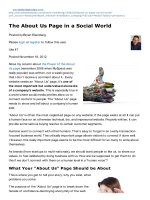wiley philanthropy in a flat world phần 9 docx
Bạn đang xem bản rút gọn của tài liệu. Xem và tải ngay bản đầy đủ của tài liệu tại đây (83.31 KB, 23 trang )
SURVIVING AND THRIVING
168
What is the vision for each area? What would it mean
to be able to achieve the ideal that you set out in the
matrix for this area? What would it mean, for example,
if all donors felt that each phone interaction with your
organization was warm, friendly, helpful, and effi cient?
What sort of difference would that make for the donors,
but more importantly (for the people you are trying to
get to change) for the organization and for them?
What would happen if you, as an organization,
decided not to make this change? What would be the
cost, both to your fundraising and to your capacity to
meet the needs of your benefi ciaries in a fast - moving
world where other organizations are starting to realize
the importance of this kind of thinking and are integrat-
ing donor satisfaction (donor delight?) as fundamental
concepts in their donor relationship management?
And what do you need to do next? What are the tan-
gible next steps that you have to take to make the move
from real to ideal? They can be small steps, in the Japanese
style of kaizen — “ constant improvement. ” There is no
need to make people fearful of a big quantum jump. That
can come later once they are on board.
The Four - Step Plan to Flat Philanthropic Success
169
Your trace is your brand. It is one of your most
powerful assets as an organization. And it is up to the
fundraiser to work out what it is, to quantify it, to qualify
it, and to make the changes that your donors are hop-
ing for. In this way, your organization can have the tools
to thrive in the world of tomorrow — by setting clear
objectives, getting out there, and making the difference!
Interestingly, while talking about change and engag-
ing donors, the Harvard Business Review published in
August 2002 a paper linking the strength of community
and innovation. The paper found that the stronger the
community, the less it innovated and grew economically.
And the less the community was linked and tied together,
the more it innovated and grew economically. What does
this tell us?
Established communities tend to have routines and
behavior patterns that normalize and discourage
people who do not fi t in.
Less established communities, where keeping up with
the Joneses is less important, are the ones where indi-
viduals feel freer to innovate and to develop new ideas.
•
•
SURVIVING AND THRIVING
170
Think of your organization as a community. Which
type would it be? A closely knit environment that
doesn ’ t encourage people to be different, or an open
environment that accepts and welcomes all types of
people and encourages them to play to their strengths
and to develop new ideas? If you fall into the fi rst cat-
egory, you ’ d probably better have a chat with your
human resources person, because as a fundraiser you are
going to be in trouble.
To succeed, we need more, not fewer nonconformists.
171
Chapter Six
Balancing Out the Future
Fundraising Mix
S
urviving and thriving is about being sexy, about
defi ning the ultimate donor experience, about being
aspirational. But more than anything it is about know-
ing where to turn for support.
Lester Salamon ’ s Global Civil Society Review, pub-
lished by John Hopkins University, tells us that, on a
global level, the vast majority (upwards of 80 percent in
some countries) of philanthropic income comes from
individuals. Then come corporates, groups, foundations,
and other sources, often with less than 10 percent each.
SURVIVING AND THRIVING
172
Will this balance stay the same while globalization and
the fl at philanthropic world shift boundaries and play-
ing fi elds around asking, giving, and receiving?
The way money comes into organizations today
is almost always in direct correlation with the way the
society operates. In a country like France, for exam-
ple, where the state has traditionally been very strong,
the vast majority of funding (up to 100 percent in cer-
tain sectors such as health care and parts of education)
comes from the public sector. In a country like the
United States, where community - based philanthropy
has traditionally been fundamental in public service
provision, it is not surprising that we fi nd higher lev-
els of individual engagement with philanthropy. So as
societies change, what does this mean for fundraising?
In France the government recently changed a law that
had prevented public universities from raising private
funds. As a result many of these institutions have, more
or less overnight, moved into active fundraising, target-
ing companies fi rst and then moving on to individuals.
Let ’ s look therefore at individuals, grant makers,
corporations, and governments and see what effect glo-
balization is having on their philanthropy.
Balancing Out the Future Fundraising Mix
173
Giving According to Whose Needs?
Cast your mind back to December 2004, just after
Christmas — the 26th, to be precise. Maybe you were
doing something similar to what I was doing — sitting
on the sofa at home, full after a veritable orgy of food
and wallowing in the overconsumption that the festival
of Christmas has become.
In fact, I was in front of the TV when it happened,
watching repeats of old shows and fi lms. The ultimate
comfort zone, some would say. Full, contented, warm,
laughing at things I had laughed at many times before.
I think I may even have been wearing slippers.
And then the story broke. “ We are getting reports
of an earthquake in Southeast Asia . . . of a tsunami . . . . ”
As the news unfurled, the horror of this catastrophe
started to become clear. The images started to fi lter
through. The rolling news services did their job, using
the full power of the fl at world platform — searching out
and fi nding amateur images from the event, and then
putting them on high rotation, feeding them into the
collective psyche. Media around the world ran images
that many of us will never forget — of the destruction,
SURVIVING AND THRIVING
174
the chaos, but more than anything of that wave coming
in and obliterating everything in its path.
Over the next few days, the world witnessed a phil-
anthropic mobilization without precedent — one that
would simply dwarf responses to Ethiopian famine,
Darfur, and every other major international catastrophe.
On January 26, one month after the event, the Chronicle
of Philanthropy reported that “ the International Federation
of Red Cross and Red Crescent Societies, together with
its network of more than 180 national societies, had
raised $ 1.2 - billion, which the organization says will be
suffi cient to pay for its relief efforts. The Federation noted
that 85 percent of the money raised had been donated or
pledged by individuals. ” Total U.S. giving at this time was
estimated at $ 597 million, way in excess of the U.S. gov-
ernmental pledge of just $ 350 million. These were serious
amounts of cash.
The wave hit on December 26th. Fundraising
started almost immediately. Well, actually, no, it didn ’ t.
Donations started pouring in almost immediately, but
organized fundraising didn ’ t start until the 28th or the
29th — most directors of fundraising were on holiday. In
the United Kingdom, the Disasters Emergency Committee
Balancing Out the Future Fundraising Mix
175
(a fantastic organization that brings together the lead-
ing overseas aid charities to fundraise together at times of
major crisis) didn ’ t launch until the 29th.
But just because we took a couple of days to get our
campaigns up and running didn ’ t mean that the public
waited. Quite the contrary. Indeed, the collective out-
pouring of philanthropic grief started almost immedi-
ately — triggered by the images and the shocking nature
of the catastrophe. And between the 25th and the 29th,
charity web sites around the world crashed one after
another because of the incredible number of donations
that were coming through.
The fi rst coordinated asks started hitting just before
the New Year. Special fundraising telethons, company col-
lections, street collections, you name it — all over the world,
in both developed and developing countries, individuals
were putting their hands in their pockets and digging deep.
Then, on the 5th of January, out of nowhere,
Doctors Without Borders went public telling donors
that they had enough money for the emergency relief
on the ground after the tsunami.
As Catrin Schulte - Hillen, U.S. program director of
M é decins sans Fronti è res (MSF), noted at the time in
SURVIVING AND THRIVING
176
an interview on the web site Democracy Now!, “ We
also want … to underline that while the tsunami disas-
ter has traumatized people in all of those countries and
has traumatized us . . . we cannot forget that there [are]
other confl icts and other crises in this world, which
sometimes we don ’ t get to see. ”
This is the crunch.
M é decins sans Fronti è res, although they caused a
huge uproar from the nongovernmental organization
(NGO) sector at the time, was right. But that really isn ’ t
the issue. Whether MSF was right or wrong, or whether
they managed the communication around the announce-
ment in an optimum way or not, is beside the point.
Because the point is that there were other confl icts
and other crises in the world, as there still are, which
we weren ’ t getting to see. The tsunami was an incred-
ible catastrophe, with more than 250,000 losing their
lives. But it was not the only catastrophe at the time, or
since. Think Darfur, or the 5.4 million people killed in
the last ten years of civil war in the Congo.
So why was the world getting into all sorts of phil-
anthropic outpourings over the tsunami, and not over
other crises? Well, there are hundreds of reasons why
Balancing Out the Future Fundraising Mix
177
the tsunami galvanized public opinion and sympathy
in the way it did, and much has been written about
this subject since the event. My aim here is not to try
to add to this opus, but to highlight what I think was
probably the key reason. Simply put, I think it was
because we had never seen a tsunami before. In fact,
more to the point, we had never had amateur video
of a tsunami destroying everything and everyone in
its path beamed into our living rooms via rolling
news media. It was new. It was powerful. And it was
shocking.
I know that I went online to the Red Cross web
site within minutes of seeing the fi rst images of the
wave on TV. And I know from asking friends and col-
leagues that I was not alone in doing this. Why did I
react this way? Simply because it was the only thing
I could possibly do to feel less helpless in the face of
such an incredible force of destruction.
We all know that philanthropic outpourings are
not directly correlated to destruction, death, or suffer-
ing, but to a number of factors or variables. We have
images on our TV screens of starving African children.
There is no longer anything new there. It was new in
SURVIVING AND THRIVING
178
1984 when the BBC journalist Michael Buerk broke
the story of the Ethiopian famine and sent these images
into our living rooms for the fi rst time. And it got a
reaction then — Band Aid, Live Aid, and others.
But let ’ s return to the tsunami and to MSF for a
minute. Essentially, MSF was saying, just a week after
the wave hit, that donors should stop giving to MSF. So
did they? Did donors stop giving to MSF? Of course
not. They kept on giving.
Why?
The answer, unfortunately, is very simple. Individuals
did not give according to the needs of the benefi ci-
aries. They gave according to their needs as donors.
Otherwise they would have stopped giving when MSF
asked them to and they would have given to other
crises like Darfur or the Congo instead.
This is a very, very worrying state of affairs. It is, of
course, one that has always existed. Every charity has a
list of things that it could fundraise for. Some of them
are easier to sell than others. The handicapped char-
ity that spends the majority of its money on putting
drunk drivers back together after accidents is not going
to raise a fortune if they write to their donors asking
Balancing Out the Future Fundraising Mix
179
to fi nance wheelchairs for drunk drivers. So they run
campaigns about poor, handicapped kids.
But the tsunami was the fi rst - ever international
catastrophe that occurred in the fl at philanthropic world.
Ethiopia, Bhopal, and Kosovo had all been pre - fl atness.
The fl at philanthropic world made it possible for
eyewitness images of the crisis to be sent within hours
into billions of homes around the world through the
Internet, cable TV, and rolling news. A simple video
taken from a mobile phone was suddenly beamed across
the world.
And the response was overwhelming. Again, remem-
ber that the fi rst active fundraising asks made by non-
profi ts did not hit until the news was at least a day old.
And the majority did not reach donors for an additional
two or three days. So who was doing the fundraising?
Initially, no one. People were making spontaneous
gifts. Enough people to crash web sites. Unprecedented
numbers of people.
And then the media became fundraisers. Then com-
panies became fundraisers. Retailers became fundraisers.
In fact, more or less anyone became a fundraiser.
And we were not prepared for any of it.
SURVIVING AND THRIVING
180
The challenge has been clearly thrown down to us
as a profession. The fl at philanthropic world has taken
the control over fundraising out of our hands. As soon
as there is an event — something worthy of media cov-
erage, which tugs on the emotional heartstrings of the
general public — we are going to fi nd ourselves increas-
ingly losing control of our fundraising.
And the real challenge is that it doesn ’ t have to be
another international catastrophe. A local event, picked
up on by local media and about which local people feel
strongly, could be enough to infl uence giving to a cause
without fundraisers getting involved. A well - known
and respected local fi refi ghter who loses his life could
provoke an outpouring of donations to the fi refi ghters ’
benevolent fund web site without the fundraisers ever
having to get involved.
And tomorrow, when the fl at world has pushed back
the boundaries of technology even further, and we can all
make donations instantly from our mobile phones using
simple voice - activation technology that then debits our
bank account and wires the funds through to the charity
of choice, it is going to become even more diffi cult to
keep the control over our fundraising.
Balancing Out the Future Fundraising Mix
181
The tsunami was the fi rst fl at world catastrophe,
and it showed us clearly how external forces like the
media and public opinion are much stronger than our
internal fundraising forces. It also won ’ t be the last. And
as technology moves forward we are going to be faced
more and more with the same reality — individuals
will increasingly give according to their needs and not
according to the needs of the benefi ciaries.
And let us not forget that more than 80 per-
cent of all privately fundraised resources come from
individuals.
This is why we are going to need some serious
balancing.
With the economy expanding at an unforeseen speed,
personal wealth reaching unimaginable heights, tech-
nological innovations making this speed faster and
faster, globalization threatening to wipe out the weak
economies and the poor people from the economic
map, it is time to consider the case of Social Business
Entrepreneurs more seriously than we did ever before.
Not only is it not necessary to leave the market
solely to the personal - gain seekers, it is extremely
SURVIVING AND THRIVING
182
harmful to mankind as a whole to do that. It is time
to move away from the narrow interpretation of capi-
talism and broaden the concept of market by giving
full recognition to Social Business Entrepreneurs . . .
to make the market work for social goals as effi ciently
as it does for personal goals.
— Muhammad Yunus, from the Grameen
Bank Web site ( www.grameen - info.org/
bank/socialbusinessentrepreneurs.htm )
High - Impact Philanthropy
If our individual donors are increasingly able to choose
their own causes and their own ways of giving regard-
less of the real needs of the benefi ciaries, we have a real
challenge. Recently, I was at a meeting with a number
of development directors from major international
NGOs discussing what to do about the changing mod-
els of philanthropy, as depicted by Kiva, Global Giving,
and others. The good old days, when we, the donor, the
benefi ciary, and the charity had a nice, interdependent
relationship, look like they may be coming to an end
Balancing Out the Future Fundraising Mix
183
forever. Donors no longer need charities to decide
where to contribute their money. They can go to Kiva
and decide precisely what benefi ciary they are going to
give to. What ’ s more, they can read all about the project
in advance, and then receive information from the ben-
efi ciary as the project develops following their donation.
Recently I went to the Kiva web site to do a bit of
research for this book, and I was met with a page on
the web site telling me that Kiva was no longer accept-
ing donations. A charity was no longer accepting dona-
tions! Kiva had more donors than it had projects that
needed fi nancing!
How many other organizations (with perhaps the
exception of MSF after the tsunami!) can you think
of that put up a web page saying they don ’ t need any
more money? I can ’ t think of many, if any.
Why is Kiva such a success? Why is Global Giving
growing so quickly? Because donors feel empowered,
feel close to the benefi ciaries, and feel that they can actu-
ally make a difference. And in addition, with Kiva, the
money is invested into a loan that is then repaid, which
means that you can reattribute your funds many times —
thereby multiplying the impact of your initial donation.
SURVIVING AND THRIVING
184
New economic models are changing the face
of philanthropy. I put the Kivas and Global Givings of
this world into a category that I call “ high - impact
philanthropy. ”
It is defi nitely a trend, and in much the same way
as globalization can be argued about forever, it is.
High - impact philanthropy now exists. And it is calling
organizations to change their thinking and, to a certain
extent, their business models.
To return to our meeting with the development
directors, the key question to come out of the discus-
sion was that large international NGOs have a challenge
ahead. They need to defi ne their added - value proposi-
tion to donors in a much clearer and more powerful way
than in the past. Brand will always be important, and as
we saw after the tsunami, it was the leading nonprofi t
organization brands (the Red Cross at the top of the list)
that picked up most of the money. But the Kivas of this
world have shown that brand is not everything and that
new operations in niche markets can quickly emerge
and position themselves as challengers.
What is it about Save the Children or Oxfam
that makes them more appropriate and effective as
Balancing Out the Future Fundraising Mix
185
destinations for philanthropy than being able to give
directly to the benefi ciary? What is it that means that
these organizations can also claim to be players in the
high - impact philanthropy market? These are questions
that have yet to be answered, but will be essential in
the development of these big organizations in the fl at
philanthropic world. After all, we have all seen how, in
the airline market, Easyjet and Southwest came from
nowhere to challenge the existing carriers. (And we
also know who is winning that particular battle.) If
someone can give me a good reason why the philan-
thropic market shouldn ’ t follow the same trends, I ’ d be
thrilled to hear it.
Capital for Good
Muhammad Yunus received the Nobel Peace Prize in
2007 for his work in promoting and developing micro-
credit and social enterprise, fi rst with the Grameen
Bank in Bangladesh and later on a wider, international
platform. He is perhaps the ultimate proponent of “ cap-
ital for good, ” one of the major trends (if not the major
trend) to emerge from the fl at philanthropic world.
SURVIVING AND THRIVING
186
The idea he develops is simple. The market is a
unidimensional entity, which exists only for one thing —
to make money. We have been very effective at creat-
ing markets that have created lots of money, and we
have also been very effective at convincing ourselves
that what we need and yearn for above all else is money.
The problem, Yunus argues, is that human beings are
not unidimensional beings. We have feelings, emotions,
irrationalities, thoughts, dreams, and so on that make
us slightly more complicated than a market. (Which is
why people are often perceived by economists as being
imperfections in the market!). As a result, it should be
possible to offer two markets — one to make money,
and another to do good. Companies should be able to
choose whether they want to make lots of money or
use their activity to do good in the world (the latter
accepting that they would probably not make as much
money, but might feel better about life as a result).
Capital being used for good. Could this just be the
future?
Recently, Ban Ki Moon, the UN secretary general,
created a new special envoy post at the organization ’ s
Balancing Out the Future Fundraising Mix
187
headquarters in New York to investigate alternative
sources of fi nancing for the Millennium Development
Goals. Faced with a cash shortfall of upwards of $ 50
billion annually to reach the goals by 2015, the former
French minister of foreign affairs, Philippe Douste -
Blazy, has been tasked with examining how to raise
serious amounts of money quickly.
I was lucky enough to be part of a consulta-
tion team working with Douste - Blazy and his team
in 2008, and the fi ndings from the group were stark.
Philanthropy was not going to be an option. In order
to get this kind of money together, the kind of money
that can bring quantum change, philanthropy was small
fry. An altogether different approach was needed, one
that would involve freeing up capital to be invested and
used for good. For results. For a better world.
From two totally different starting points, Yunus
and Douste - Blazy were coming to the same conclusion.
Social enterprise, the freeing up of capital for good, and
social investment were likely to free up much more
positive change than philanthropy in both the short
term and the long term.
SURVIVING AND THRIVING
188
Is philanthropy failing? Could it be that the philan-
thropic model is becoming so polluted with short - term
individual need that it is losing sight of the big picture
and as a result failing to pull together the kind of money
needed to promote real change?
How else could we explain the fact that in 1985,
the Live Aid concerts around the world asked people to
put their hands in their pockets and give money, while
in 2005, the Live 8 concerts asked people to put their
hands on their keyboards and give their voice as a way
to lobby the G - 8 leaders to make change that would go
way beyond philanthropy? As Bob Geldof said during
his keynote speech at the Association of Fundraising
Professionals Conference in San Diego in 2008: “ In
1985 we raised $ 200 million. In 2005 we lobbied for
change and got $ 50 billion. ”
Is philanthropy a stopgap or a solution? If you lis-
ten to Yunus and Geldof, it would appear that they are
saying it is the former — that it is essential, but that in
the fl at philanthropic world, in order to meet a set of
exponential needs, we need more than philanthropy.
We need to:
Balancing Out the Future Fundraising Mix
189
Mobilize capital for good.
Facilitate changes in policy that would produce
more equity and reduce the need for philanthropy
as a long - term solution.
Facilitate changes that would make it more attrac-
tive to invest capital in the long term for good.
There is still enough money saved in banks, endow-
ments, and investments today to deal with the world ’ s
problems — starting of course with the Millennium
Development Goals. The problem today, according to
Yunus, is that it is being invested in such a way that it
is making the wrong people richer and is being driven
toward short - term gain. This capital, if invested in long -
term projects to help communities develop through
integration of social business and enterprise, and accom-
panied by governmental investments in infrastructure,
education, and technology, could have much more posi-
tive outputs for the world of tomorrow.
I would argue that philanthropy today is, on the
whole, not having this debate. We are not seeing our-
selves as a springboard or a conduit for larger, more
•
•
•
SURVIVING AND THRIVING
190
fundamental change. Unless philanthropy can reposition
itself as a facilitator for this big change, it will be out-
performed and outsmarted by new business and eco-
nomically motivated, results - driven social enterprise.
Jeremy Hockenstein is a Harvard graduate who
at the end of his studies was faced with the double -
whammy choice laid out for us by Yunus: make money
or do good. Jeremy did what many of his generation
are now doing — decided to not make the choice, but
to actively choose both.
He started a not - for - profi t fi rm in Cambodia called
Digital Divide to provide outsourced data entry serv-
ices for American companies. The company provides,
at a reduced rate, data entry services to U.S. companies
that most would not be able to afford if done within the
United States. At the same time, it pays its Cambodian
employees twice the minimum wage for a part - time
job, while providing scholarships for its employees to go
to school. The company has developed partnerships in
Cambodia with educational NPOs working with the
poorest of the poor to train new employees, thereby
ensuring that kids who might have ended up living off
landfi ll sites now have a future for themselves and their









